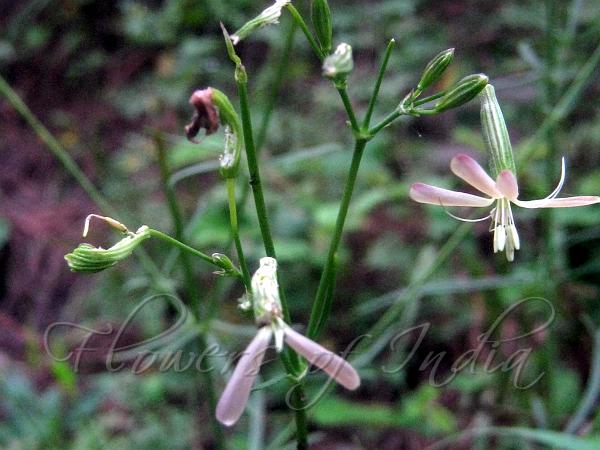|
| West-Himalayan Campion |
|

|

| File size | 872996 |
| Original date | 9/4/11 4:31 PM |
| Resolution | 2736 x 2052 |
| Flash | Flash did not fire, auto |
| Focal length | 6.6mm |
| Exposure time | 1/500s |
| Aperture | 3.0 |
| Focus Distance | |
| Metering Mode | Multi-segment |
| Camera make | Canon |
| Camera model | Canon PowerShot A495 |
| Sensor type | OneChipColorArea |
|
|
|
|
Photo: |
Botanical name: Silene falconeriana Family: Caryophyllaceae (Carnation family)
West-Himalayan Campion is a biennial or perennial herb,
up to 50 cm tall. It is named for Hugh Falconer, 19th century Scottish
doctor, geologist and botanist in India. Stems are more or less leafy,
thick, simple or branched, velvety below, hairless above. Leaves are
2-5 cm long, 2-7 mm wide, inverted-lanceshaped to linear-lanceshaped to
linear, tip pointed, base narrow, velvety or hairless. Bracts are
linear, pointed. Flowers are borne in panicles, the lateral branches
ending in lax or congested cymes. Flower-stalks are usually hairless.
Sepal-tube is 8-10 mm, cylindrical, narrow at the base, club-shaped and
constricted below the capsule, in fruit hairless. Teeth are triangular,
blunt with ciliate margins. Nerves are brownish, prominent. Petals are
greenish-yellow to reddish-brown, white, limb about 5 mm, spoon-shaped
not lobed. Coronal scales are absent. Capsule is about 8 mm, ovoid,
barely peeping out from the sepal tube. West-Himalayan Campion is found in
W. Himalaya, from Kashmir to Nepal, at altitudes up to 2500 m.
Flowering: July-August.
| Identification credit: Krishan Lal | Photographed in Sirmaur Distt, Himachal Pradesh & Lansdowne, Uttrakhand. |
• Is this flower misidentified? If yes,